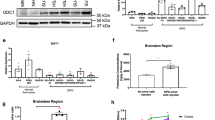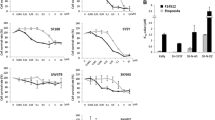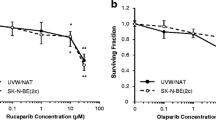Abstract
Polyamine synthesis inhibitors, such as α-difluoromethylornithine (DFMO), inhibit tumor cell growth in vitro and in vivo. However, upon cessation of treatment, tumor growth resumes. We hypothesized that incorporation of radioactive polyamines might kill the growth-arrested cells. This hypothesis was previously tested in rat 9L brain tumor cells in which DFMO increased both the uptake and the retention of [3H] putrescine. In these rat cells, DFMO-induced retention of high-specific-activity [3H] putrescine for 20 days resulted in several logs killing. In the present studies all of the 5 different human glioma cell lines tested with DFMO treatment also showed enhanced uptake of exogenous [3H] putrescine, reduced cell counts and enhanced killing of colony forming cells (CSF). Extending the time of DFMO treatment of cells that had taken up high-specific-activity (80 Ci/mmol) [3H] putrescine further increased the killing. A 10-day extension resulted in a 10,000-fold reduction in cumulative cell growth. A 5-day extension resulted in a 2–3 log decrease in numbers of surviving CFC. These data further support the hypothesis and suggest that DFMO-induced cell cycle arrest enhances cellular retention of [3H] putrescine, increasing the effective internal radiation dose enough to cause proliferative death. In a clinical setting, the short (∼ 1 μm) path-length of the tritium β particle should limit effects to the tumor cells and spare adjacent normal cells. These results support the concept that treatment with the combination of polyamine inhibitors and radioactive polyamines might be a useful adjunct to current therapies for glioblastoma multiforme.
Similar content being viewed by others
References
Pegg AE: Polyamine metabolism and its importance in neoplastic growth and a target for chemotherapy. Cancer Res 48: 759, 1988
Mamont PS, Siat M, Joder-Ohlenbusch AM, Bernhardt A, Casara P: Effects of (2R, 5R)-6-heptyne-2,5-diamine, a potent inhibitor of L-ornithine decarboxylase, on rat hepatoma cells cultured in vitro. Eur J Biochem 142: 457, 1984
McCann PP, Pegg AE: Ornithine decarboxylase as an enzyme target for therapy. Pharmacol Ther 54: 195, 1992
Seidenfeld J, Gray JW, Marton LJ: Depletion of 9L rat brain tumor cell polyamine content by treatment with D,L-alphadifluoromethylornithine inhibits proliferation and the G1 to S transition. Exp Cell Res 131: 209, 1981
Chaney JE, Kobayashi K, Goto R, Digenis GA: Tumor selective enhancement of radioactivity uptake in mice treated with alpha-difluoromethylornithine prior to administration of 14C-putrescine. Life Sciences 32: 1237, 1983
Redgate ES, Grudziak A, Floyd KL, Deutsch M, Boggs SS: Effect of D,L-alpha-difluoromethylornithine (DFMO) enhanced [3H]putrescine uptake on 9L tumor cell growth and colony forming efficiency. Int J Radiat Oncol Biol Phys 25: 639, 1993
Redgate ES, Grudziak AG, Deutsch M, Boggs SS: Difluoromethylornithine enhanced uptake of tritiated putrescine in 9L rat brain tumors. Int J Radiat Oncol Biol Phys 38: 169, 1997
Redgate ES, Grudziak AG, Deutsch M, Boggs SS: Enhanced uptake of [3H] spermidine by 9L rat brain tumors after direct intratumoral infusion of inhibitors of enzymes of the polyamine biosynthetic pathway. J Neuro-Oncol 42: 123, 1999
Redgate ES, Boggs S, Grudziak A, Deutsch M: Polyamines in brain tumor therapy. J Neuro-Oncol 25: 167, 1995
Stinson SF, Alley MC, Kopp WC, Fiebig HH, Mullendore LA, Pittman AF, Kenney S, Keller J, Boyd MR: Morphological and immunocytochemical characteristics of human tumor cell lines for use in a disease-oriented anticancer drug screen. Anticancer Res 12: 1035, 1992
Rosenblum ML, Dougherty DV, Deen DF, Wilson CB: Potentials and limitations of a clonogenic cell assay for human brain tumors. Cancer Treat Reports 65: 61, 1981
Sturtz FG, Waddell K, Shulok J, Chen X, Snodgrass HR, Platika D: Parameters influencing the efficiency of the thymidine kinase/ganciclovir strategy in human glioblastoma cell lines. Stereotact Funct Neurosurg 68: 252, 1997
Welch WC, Morrison RS, Gross JL, Gollin SM, Kitson RB, Goldfarb RH, Giuliano KA, Bradley MK, Kornblith PL: Morphologic, immunologic, biochemical, and cytogenetic characteristics of the human glioblastoma-derived cell line, SNB-19. In Vitro Cel Develop Biol Animal 31: 610, 1995
Blackett NM, Gordon MY: Optimizing limiting dilution assays: frequency and ‘ability’ measurements of haemopoietic progenitor cells (see comments). Br J Haematol 92: 507, 1996
Taswell C: Limiting dilution assays for the determination of immunocompetent cell frequencies. III.Validity tests for the single-hit Poisson model. J Immunol Methods 72: 29, 1984
Boggs S, Grudziak AG, Deutsch M, Redgate ES: Combining D,L-alpha-difluoromrthylornithine with [3h] thymidine increases killing of rat gliosarcoma cells in vitro. Radiol Oncol Investig 1: 325, 1994
Sarhan S, Seiler N: On the subcellular localization of the polyamines. Biol Chem Hoppe-Seyler 370: 1279, 1989
Sarhan S, Weibel M, Seiler N: Effect of polyamine deprivation on the survival of intracranial glioblastoma bearing rats. Anticancer Res 11: 987, 1991
Marton LJ, Pegg AE: Polyamines as targets for therapeutic intervention. Ann Rev Pharmacol Toxicol 35: 55, 1995
Levin VA, Prados MD, Yung WK, Gleason MJ, Ictech S, Malec M: Treatment of recurrent gliomas with eflornithine. J Natl Cancer Inst 84: 1432, 1992
Author information
Authors and Affiliations
Rights and permissions
About this article
Cite this article
Redgate, E.S., Alexander, D., Ryan Magra, T. et al. The Effect of DFMO Induced Uptake of [3H] Putrescine On Human Glioma Cells. J Neurooncol 55, 71–80 (2001). https://doi.org/10.1023/A:1013348227892
Issue Date:
DOI: https://doi.org/10.1023/A:1013348227892




